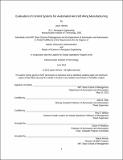| dc.contributor.advisor | Julie A. Shah and Roy E. Welsch. | en_US |
| dc.contributor.author | Herrera, Jason (Jason Richard) | en_US |
| dc.contributor.other | Leaders for Global Operations Program. | en_US |
| dc.date.accessioned | 2013-11-18T20:41:06Z | |
| dc.date.available | 2013-11-18T20:41:06Z | |
| dc.date.copyright | 2013 | en_US |
| dc.date.issued | 2013 | en_US |
| dc.identifier.uri | http://hdl.handle.net/1721.1/82484 | |
| dc.description | Thesis (M.B.A.)--Massachusetts Institute of Technology, Sloan School of Management; and, (S.M.)--Massachusetts Institute of Technology, Dept. of Aeronautics and Astronautics; in conjunction with the Leaders for Global Operations Program at MIT, 2013. | en_US |
| dc.description | This electronic version was submitted and approved by the author's academic department as part of an electronic thesis pilot project. The certified thesis is available in the Institute Archives and Special Collections. | en_US |
| dc.description | Cataloged from department-submitted PDF version of thesis | en_US |
| dc.description | Includes bibliographical references (p. 62-64). | en_US |
| dc.description.abstract | The Boeing Company is looking to bring aircraft manufacturing technology into the 21st century. As part of this process, several projects have been started to develop the technologies required to achieve Boeing's vision for the future of aircraft manufacturing. To date, much of this work has focused on hardware, including robotic and other automation technologies. However, in order to use this hardware, a significant effort must also be made in the area of factory control and coordination. This thesis advances knowledge in this area by evaluating the suitability of different control system approaches for aircraft wing box assembly. First, general classes of control systems are discussed and several criteria are proposed for evaluating their performance in an aircraft manufacturing environment. The current wing box assembly process is then examined in order to develop simplified but representative task networks to which various algorithms can be applied. The Tercio algorithm, developed at MIT, is used to generate schedules for several problem structures of interest in order to characterize the algorithm's performance in this context. The Tercio algorithm is then benchmarked against the Aurora scheduling tool, showing that Tercio can generate more efficient schedules than Aurora, but at the cost of increased computation time. Next, management considerations with respect to product design, manufacturing technology development, and implementation associated with advanced manufacturing technologies are discussed. Finally, recommendations are provided for how Boeing can accelerate the development of useful and practical advanced, automated manufacturing systems. | en_US |
| dc.description.statementofresponsibility | by Jason Herrera. | en_US |
| dc.format.extent | 64 p. | en_US |
| dc.language.iso | eng | en_US |
| dc.publisher | Massachusetts Institute of Technology | en_US |
| dc.rights | M.I.T. theses are protected by
copyright. They may be viewed from this source for any purpose, but
reproduction or distribution in any format is prohibited without written
permission. See provided URL for inquiries about permission. | en_US |
| dc.rights.uri | http://dspace.mit.edu/handle/1721.1/7582 | en_US |
| dc.subject | Aeronautics and Astronautics. | en_US |
| dc.subject | Sloan School of Management. | en_US |
| dc.subject | Leaders for Global Operations Program. | en_US |
| dc.title | Evaluation of control systems for automated aircraft wing manufacturing | en_US |
| dc.type | Thesis | en_US |
| dc.description.degree | S.M. | en_US |
| dc.description.degree | M.B.A. | en_US |
| dc.contributor.department | Leaders for Global Operations Program at MIT | en_US |
| dc.contributor.department | Massachusetts Institute of Technology. Department of Aeronautics and Astronautics | |
| dc.contributor.department | Sloan School of Management | |
| dc.identifier.oclc | 862232623 | en_US |
